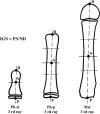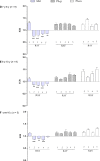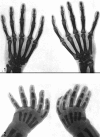The missing segment of the autopod 1st ray: new insights from a morphometric study of the human hand
- PMID: 30368800
- PMCID: PMC6231165
- DOI: 10.1111/joa.12883
The missing segment of the autopod 1st ray: new insights from a morphometric study of the human hand
Abstract
Whether the 1st segment of the human autopod 1st ray is a 'true' metapodial with loss of the proximal or mid phalanx or the original basal phalanx with loss of the metacarpal has been a long-lasting discussion. The actual knowledge of the developmental pattern of upper autopod segments at a fetal age of 20-22 weeks, combined with X-ray morphometry of normal long bones of the hand in the growing ages, was used for analysis of the parameters, percentage length, position of epiphyseal ossification centers and proximal/distal growth rate. The symmetric growth pattern in the fetal anlagen changed to unidirectional in the postnatal development in relation to epiphyseal ossification formation. The percentage length assessment, the distribution of the epiphyseal ossification centers, and differential proximal/distal growth rate among the growing hand segments supported homology of most proximal segment of the thumb with the 2nd-5th proximal phalanges and that of the proximal phalanx of the thumb with the 2nd-5th mid phalanges in the same hand. Published case reports of either metanalysis of 'triphalangeal thumb' and 'proximal/distal epiphyseal ossification centers' were used to support the applied morphometric methodology; in particular, the latter did not give evidence of growth pattern inversion of the proximal segment of the thumb. The presented data support the hypothesis that during evolution, the lost segment of the autopod 1st ray is the metacarpal.
Keywords: autopod fetal anlage growth; fetal ossification pattern; morphometric and patterning homology; postnatal ossification pattern.
© 2018 Anatomical Society.
Figures









References
-
- Bever GS, Gauthier JA, Wagner GP (2011) Finding the frame shift, digit loss developmental variability, and the origin of the avian hand. Evol Dev 13, 269–279. - PubMed
-
- Bland JM, Altman DG (2010) Statistical methods for assessing agreement between two methods of clinical measurement. Int J Nurs Stud 47, 931–936. - PubMed
-
- Blauth W (1967) Der hypoplastischeDaumen. Arch OrthopUnfallchir 62, 225–246. - PubMed

